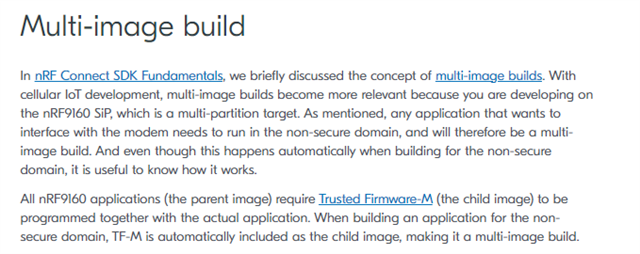Hello. I am just getting into nRF and in particular cellular devices.
After playing around with nRF9160DK, I have come up with a number of questions that is not fully clear to me. I would appreciate if someone could help me with the questions
1. I am particularly confused about multi image builds:

Is that something that happens behind the curtains when you select nRF9160DK as build target? Or do I need to manually configure my project for multi image build? I have followed lesson 2 in cellular IoT and I was able to build the simple application without enabling any of the configurations for the multi image and TFM.
Can I build just a single image (normal application as I usually do) for the nRF91? Or nRF91 strictly requires multi image builds to function properly?
2. Understanding TF-M
I have read through:
https://developer.nordicsemi.com/nRF_Connect_SDK/doc/latest/nrf/security/tfm.html#ug-tfm
But it is still quite difficult to fully grasp why I would want to use it and what are the exact use cases where this is required? Perhaps you could suggest some reading material or could help me understand it further? How do I decide if I need this in my application or not? What are the differences between normal application and TF-M application from a normal user point of view and from a developer point of view?
3.The basic usage of nRF91
I am quite new to Cellular and LTE technology, but I had a chance to play with Quectel BG95 modem. From what I have learned, normally when you are interacting with Modem, you rarely need to flash any firmware to the modem (it comes with factory firmware that you can control with AT commands), and you normally use AT commands to communicate with the modem through host MCU. From what I understood, that is not exactly the case with the nRF91. In order for the Modem to respond to any AT commands, you still need to flash some application (such as serial LTE Modem application) or some other application. Is my understanding correct?
For example, I have tried to build and flash sample project zephyr\samples\tfm_integration\tfm_secure_partition
The serial terminal prints:
*** Booting nRF Connect SDK v2.5.0 *** Digest: be45cb2605bf36bebde684841a28f0fd43c69850a3dce5fedba69928ee3a8991 Digest: 1452c8f04245d355722fdbfb03c69bcfd380b7dff911a3e425013397251f6a4e Digest: d3b4349010abb691b9584b6fd6b41ec54596ef7b98d853fb4f5bfa690f50f222 Digest: 5afbcfede855ca834ff5b4e8a44a32206a51381f3cf52f5001a3241f017ac41a Digest: 983318380c325099da63de2e7ca57c1630693b28b4754e08817533295dbfcfbb No valid secret for key, received expected error code
I do not understand the relevance of this sample project? What is it intended to show? What could be the real world use for this sample?



